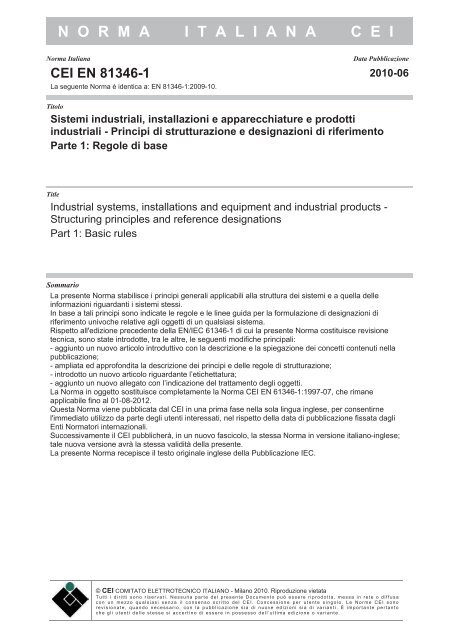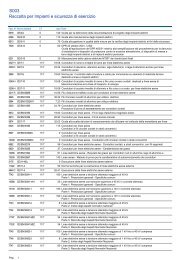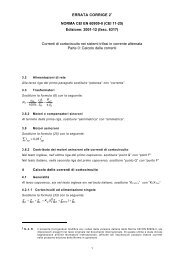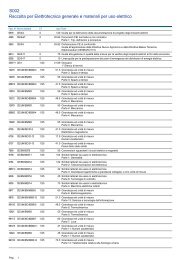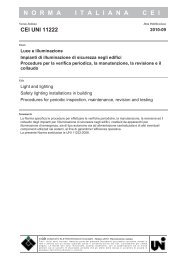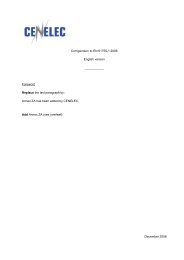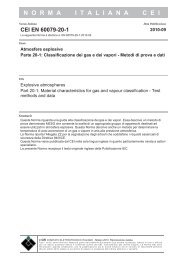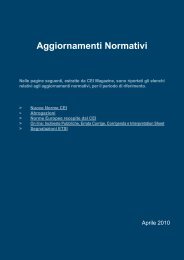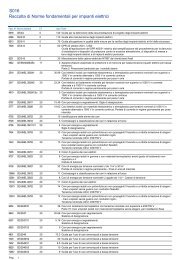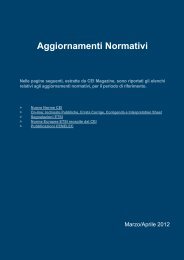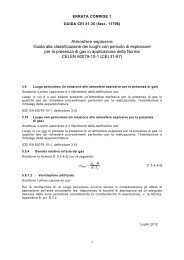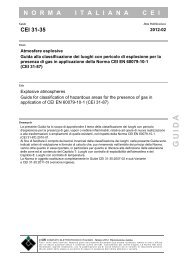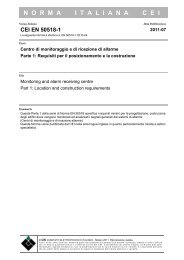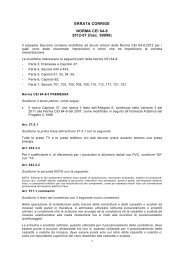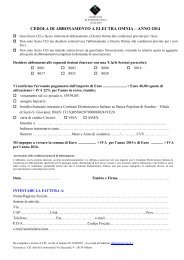EN 81346-1 - CEI
EN 81346-1 - CEI
EN 81346-1 - CEI
Create successful ePaper yourself
Turn your PDF publications into a flip-book with our unique Google optimized e-Paper software.
N O R M A I T A L I A N A C E I<br />
Norma Italiana<br />
Data Pubblicazione<br />
<strong>CEI</strong> <strong>EN</strong> <strong>81346</strong>-1 2010-06<br />
La seguente Norma è identica a: <strong>EN</strong> <strong>81346</strong>-1:2009-10.<br />
Titolo<br />
Sistemi industriali, installazioni e apparecchiature e prodotti<br />
industriali - Principi di strutturazione e designazioni di riferimento<br />
Parte 1: Regole di base<br />
Title<br />
Industrial systems, installations and equipment and industrial products -<br />
Structuring principles and reference designations<br />
Part 1: Basic rules<br />
Sommario<br />
La presente Norma stabilisce i principi generali applicabili alla struttura dei sistemi e a quella delle<br />
informazioni riguardanti i sistemi stessi.<br />
In base a tali principi sono indicate le regole e le linee guida per la formulazione di designazioni di<br />
riferimento univoche relative agli oggetti di un qualsiasi sistema.<br />
Rispetto all'edizione precedente della <strong>EN</strong>/IEC 61346-1 di cui la presente Norma costituisce revisione<br />
tecnica, sono state introdotte, tra le altre, le seguenti modifiche principali:<br />
- aggiunto un nuovo articolo introduttivo con la descrizione e la spiegazione dei concetti contenuti nella<br />
pubblicazione;<br />
- ampliata ed approfondita la descrizione dei principi e delle regole di strutturazione;<br />
- introdotto un nuovo articolo riguardante l’etichettatura;<br />
- aggiunto un nuovo allegato con l’indicazione del trattamento degli oggetti.<br />
La Norma in oggetto sostituisce completamente la Norma <strong>CEI</strong> <strong>EN</strong> 61346-1:1997-07, che rimane<br />
applicabile fino al 01-08-2012.<br />
Questa Norma viene pubblicata dal <strong>CEI</strong> in una prima fase nella sola lingua inglese, per consentirne<br />
l'immediato utilizzo da parte degli utenti interessati, nel rispetto della data di pubblicazione fissata dagli<br />
Enti Normatori internazionali.<br />
Successivamente il <strong>CEI</strong> pubblicherà, in un nuovo fascicolo, la stessa Norma in versione italiano-inglese;<br />
tale nuova versione avrà la stessa validità della presente.<br />
La presente Norma recepisce il testo originale inglese della Pubblicazione IEC.<br />
© <strong>CEI</strong> COMITATO ELETTROTECNICO ITALIANO - Milano 2010. Riproduzione vietata<br />
Tutti i diritti sono riservati. Nessuna parte del presente Documento può essere riprodotta, messa in rete o diffusa<br />
con un mezzo qualsiasi senza il consenso scritto del <strong>CEI</strong>. Concessione per utente singolo. Le Norme <strong>CEI</strong> sono<br />
revisionate, quando necessario, con la pubblicazione sia di nuove edizioni sia di varianti. È importante pertanto<br />
che gli utenti delle stesse si accertino di essere in possesso dell’ultima edizione o variante.
DATI ID<strong>EN</strong>TIFICATIVI <strong>CEI</strong><br />
Norma italiana <strong>CEI</strong> <strong>EN</strong> <strong>81346</strong>-1<br />
Classificazione <strong>CEI</strong> 3-62<br />
Edizione<br />
COLLEGAM<strong>EN</strong>TI/RELAZIONI TRA DOCUM<strong>EN</strong>TI<br />
Nazionali<br />
(SOC) <strong>CEI</strong> <strong>EN</strong> 61346-1:1997-07; fasc. 3530 che rimane applicabile fino al<br />
01-08-2012;<br />
Europei (IDT) <strong>EN</strong> <strong>81346</strong>-1:2009-10;<br />
Internazionali (IDT) IEC <strong>81346</strong>-1:2009-07;<br />
Legislativi<br />
Legenda<br />
(SOC) - La Norma in oggetto sostituisce completamente le Norme indicate dopo il riferimento (SOC)<br />
(IDT) - La Norma in oggetto è identica alle Norme indicate dopo il riferimento (IDT)<br />
INFORMAZIONI EDITORIALI<br />
Pubblicazione<br />
Stato Edizione<br />
Norma Tecnica<br />
In vigore<br />
Data validità 01-07-2010<br />
Ambito validità<br />
Fascicolo<br />
Ed. Prec. Fasc.<br />
Comitato Tecnico<br />
Internazionale<br />
10470 E<br />
Nessuna<br />
CT 3/16-Strutture delle informazioni, documentazioni, segni grafici, contrassegni e altre<br />
identificazioni (ex CT 3, ex CT 16)<br />
Approvata da Presidente del <strong>CEI</strong> In data 14-05-2010<br />
C<strong>EN</strong>ELEC In data 01-08-2009<br />
Sottoposta a Inchiesta pubblica come Documento originale Chiusura in data 17-07-2009<br />
ICS 01.110; 29.020;<br />
2
Recepita come <strong>CEI</strong> <strong>EN</strong> <strong>81346</strong>-1:2010-06<br />
EUROPEAN STANDARD <strong>EN</strong> <strong>81346</strong>-1<br />
NORME EUROPÉ<strong>EN</strong>NE<br />
EUROPÄISCHE NORM October 2009<br />
ICS 01.110; 29.020 Supersedes <strong>EN</strong> 61346-1:1996<br />
English version<br />
Industrial systems, installations and equipment and industrial products -<br />
Structuring principles and reference designations -<br />
Part 1: Basic rules<br />
(IEC <strong>81346</strong>-1:2009)<br />
Systèmes industriels, installations<br />
et appareils, et produits industriels -<br />
Principes de structuration<br />
et désignations de référence -<br />
Partie 1: Règles de base<br />
(<strong>CEI</strong> <strong>81346</strong>-1:2009)<br />
Industrielle Systeme, Anlagen<br />
und Ausrüstungen und Industrieprodukte -<br />
Strukturierungsprinzipien<br />
und Referenzkennzeichnung -<br />
Teil 1: Allgemeine Regeln<br />
(IEC <strong>81346</strong>-1:2009)<br />
This European Standard was approved by C<strong>EN</strong>ELEC on 2009-08-01. C<strong>EN</strong>ELEC members are bound to comply<br />
with the C<strong>EN</strong>/C<strong>EN</strong>ELEC Internal Regulations which stipulate the conditions for giving this European Standard<br />
the status of a national standard without any alteration.<br />
Up-to-date lists and bibliographical references concerning such national standards may be obtained on<br />
application to the Central Secretariat or to any C<strong>EN</strong>ELEC member.<br />
This European Standard exists in three official versions (English, French, German). A version in any other<br />
language made by translation under the responsibility of a C<strong>EN</strong>ELEC member into its own language and notified<br />
to the Central Secretariat has the same status as the official versions.<br />
C<strong>EN</strong>ELEC members are the national electrotechnical committees of Austria, Belgium, Bulgaria, Cyprus, the<br />
Czech Republic, Denmark, Estonia, Finland, France, Germany, Greece, Hungary, Iceland, Ireland, Italy, Latvia,<br />
Lithuania, Luxembourg, Malta, the Netherlands, Norway, Poland, Portugal, Romania, Slovakia, Slovenia, Spain,<br />
Sweden, Switzerland and the United Kingdom.<br />
C<strong>EN</strong>ELEC<br />
European Committee for Electrotechnical Standardization<br />
Comité Européen de Normalisation Electrotechnique<br />
Europäisches Komitee für Elektrotechnische Normung<br />
Central Secretariat: Avenue Marnix 17, B - 1000 Brussels<br />
© 2009 C<strong>EN</strong>ELEC - All rights of exploitation in any form and by any means reserved worldwide for C<strong>EN</strong>ELEC members.<br />
Ref. No. <strong>EN</strong> <strong>81346</strong>-1:2009 E
Recepita come <strong>CEI</strong> <strong>EN</strong> <strong>81346</strong>-1:2010-06<br />
<strong>EN</strong> <strong>81346</strong>-1:2009 - 2 -<br />
Foreword<br />
The text of document 3/947/FDIS, future edition 1 of IEC <strong>81346</strong>-1, prepared by IEC TC 3, Information<br />
structures, documentation and graphical symbols, in close co-operation with ISO TC 10, Technical<br />
product documentation, was submitted to the IEC-C<strong>EN</strong>ELEC parallel vote and was approved by<br />
C<strong>EN</strong>ELEC as <strong>EN</strong> <strong>81346</strong>-1 on 2009-08-01.<br />
This European Standard supersedes <strong>EN</strong> 61346-1:1996.<br />
<strong>EN</strong> <strong>81346</strong>-1:2009 includes the following substantial changes with respect to <strong>EN</strong> 61346-1:1996:<br />
– a new introductory clause providing a description and explanation to the concepts used elsewhere in<br />
the publication;<br />
– a more comprehensive description of the structuring principles and rules for structuring are provided;<br />
– “other aspects” are introduced, and the prefix sign # is assigned to these aspects;<br />
– the concept of reference designation group has been deleted;<br />
– the specific term “transition” has been avoided and been replaced by an improved textual description<br />
of this phenomenon in Annex D;<br />
– a new clause about labelling is introduced;<br />
– the old annexes have been removed with the exception of the annex showing an example of the<br />
application of reference designations within a system;<br />
– a new annex explaining the manipulation of objects is introduced;<br />
– 4 new annexes are introduced as rearrangement of detailed examples or explanatory information.<br />
The following dates were fixed:<br />
– latest date by which the <strong>EN</strong> has to be implemented<br />
at national level by publication of an identical<br />
national standard or by endorsement (dop) 2010-05-01<br />
– latest date by which the national standards conflicting<br />
with the <strong>EN</strong> have to be withdrawn (dow) 2012-08-01<br />
Annex ZA has been added by C<strong>EN</strong>ELEC.<br />
__________
Recepita come <strong>CEI</strong> <strong>EN</strong> <strong>81346</strong>-1:2010-06<br />
- 3 - <strong>EN</strong> <strong>81346</strong>-1:2009<br />
Endorsement notice<br />
The text of the International Standard IEC <strong>81346</strong>-1:2009 was approved by C<strong>EN</strong>ELEC as a European<br />
Standard without any modification.<br />
In the official version, for Bibliography, the following notes have to be added for the standards indicated:<br />
IEC 60297-3-101<br />
IEC 61082-1<br />
IEC 61335-1<br />
IEC 62023<br />
IEC 62027<br />
IEC 62491<br />
IEC <strong>81346</strong>-2<br />
ISO 3166-1<br />
ISO 4157<br />
NOTE Harmonized as <strong>EN</strong> 60297-3-101:2004 (not modified).<br />
NOTE Harmonized as <strong>EN</strong> 61082-1:2006 (not modified).<br />
NOTE Harmonized as <strong>EN</strong> 61335-1:2008 (not modified).<br />
NOTE Harmonized as <strong>EN</strong> 62023:2000 (not modified).<br />
NOTE Harmonized as <strong>EN</strong> 62027:2000 (not modified).<br />
NOTE Harmonized as <strong>EN</strong> 62491:2008 (not modified).<br />
NOTE Harmonized as <strong>EN</strong> <strong>81346</strong>-2:2009 (not modified).<br />
NOTE Harmonized as <strong>EN</strong> ISO 3166-1:2006 (not modified).<br />
NOTE Harmonized in <strong>EN</strong> ISO 4157 series (not modified).<br />
__________
Recepita come <strong>CEI</strong> <strong>EN</strong> <strong>81346</strong>-1:2010-06<br />
<strong>EN</strong> <strong>81346</strong>-1:2009 - 4 -<br />
Annex ZA<br />
(normative)<br />
Normative references to international publications<br />
with their corresponding European publications<br />
The following referenced documents are indispensable for the application of this document. For dated<br />
references, only the edition cited applies. For undated references, the latest edition of the referenced<br />
document (including any amendments) applies.<br />
NOTE When an international publication has been modified by common modifications, indicated by (mod), the relevant <strong>EN</strong>/HD<br />
applies.<br />
Publication Year Title <strong>EN</strong>/HD Year<br />
ISO/IEC 646 - 1) Information technology - ISO 7-bit coded<br />
character set for information interchange<br />
- -
Recepita come <strong>CEI</strong> <strong>EN</strong> <strong>81346</strong>-1:2010-06<br />
IEC <strong>81346</strong>-1<br />
Edition 1.0 2009-07<br />
INTERNATIONAL<br />
STANDARD<br />
NORME<br />
INTERNATIONALE<br />
colour<br />
inside<br />
Industrial systems, installations and equipment and industrial products –<br />
Structuring principles and reference designations –<br />
Part 1: Basic rules<br />
Systèmes industriels, installations et appareils, et produits industriels –<br />
Principes de structuration et désignations de référence –<br />
Partie 1: Règles de base<br />
INTERNATIONAL<br />
ELECTROTECHNICAL<br />
COMMISSION<br />
COMMISSION<br />
ELECTROTECHNIQUE<br />
INTERNATIONALE<br />
PRICE CODE<br />
CODE PRIX<br />
XC<br />
ICS 01.110; 29.020<br />
ISBN 2-8318-1054-7
Recepita come <strong>CEI</strong> <strong>EN</strong> <strong>81346</strong>-1:2010-06<br />
– 2 – <strong>81346</strong>-1 © IEC:2009<br />
CONT<strong>EN</strong>TS<br />
FOREWORD...........................................................................................................................6<br />
INTRODUCTION.....................................................................................................................8<br />
0.1 General ...................................................................................................................8<br />
0.2 Basic requirements for this standard .......................................................................8<br />
0.3 Required properties of the standard ........................................................................9<br />
1 Scope.............................................................................................................................11<br />
2 Normative references .....................................................................................................11<br />
3 Terms and definitions .....................................................................................................11<br />
4 Concepts ........................................................................................................................13<br />
4.1 Object ...................................................................................................................13<br />
4.2 Aspect...................................................................................................................14<br />
4.3 Technical system...................................................................................................15<br />
4.4 Structuring ............................................................................................................16<br />
4.5 Function ................................................................................................................16<br />
4.6 Products and components .....................................................................................16<br />
4.7 Location ................................................................................................................17<br />
4.8 Types, occurrences and individuals .......................................................................18<br />
5 Structuring principles......................................................................................................20<br />
5.1 General .................................................................................................................20<br />
5.2 Forming structures (i.e. types and occurrences) ....................................................21<br />
5.3 Function-oriented structure....................................................................................24<br />
5.4 Product-oriented structure .....................................................................................25<br />
5.5 Location-oriented structure....................................................................................26<br />
5.6 Structures based on “other aspects” ......................................................................27<br />
5.7 Structures based on more than one aspect............................................................28<br />
6 Construction of reference designations...........................................................................29<br />
6.1 General .................................................................................................................29<br />
6.2 Format of reference designations ..........................................................................29<br />
6.2.1 Single level................................................................................................29<br />
6.2.2 Multi-level..................................................................................................30<br />
6.2.3 Use of letter codes ....................................................................................31<br />
6.3 Different structures within the same aspect ...........................................................31<br />
7 Reference designation set ..............................................................................................32<br />
8 Designation of locations .................................................................................................33<br />
8.1 General .................................................................................................................33<br />
8.2 Assemblies............................................................................................................33<br />
9 Presentation of reference designations...........................................................................35<br />
9.1 Reference designations.........................................................................................35<br />
9.2 Reference designations set ...................................................................................36<br />
9.3 Presentation of identifiers for the top-node ............................................................37<br />
10 Labelling ........................................................................................................................38<br />
Annex A (informative) Historical background........................................................................39<br />
Annex B (informative) Establishment and life cycle of objects ..............................................41<br />
Annex C (informative) Manipulation of objects .....................................................................52<br />
Annex D (informative) Interpretation of reference designations using different aspects ........64
Recepita come <strong>CEI</strong> <strong>EN</strong> <strong>81346</strong>-1:2010-06<br />
<strong>81346</strong>-1 © IEC:2009 – 3 –<br />
Annex E (normative) Object represented with several top nodes in an aspect ......................67<br />
Annex F (informative) Examples of multiple structures based on the same aspect ...............69<br />
Annex G (informative) Example of structures and reference designations ............................73<br />
Annex H (informative) Example of reference designations within a system...........................75<br />
Bibliography..........................................................................................................................82<br />
Figure 1 – International standards providing a consistent system for designation,<br />
documentation and presentation of information .....................................................................10<br />
Figure 2 – Illustration of an object.........................................................................................13<br />
Figure 3 – Aspects of an object.............................................................................................15<br />
Figure 4 – Illustration of a function and its sub-functions.......................................................16<br />
Figure 5 – Illustration of the concepts product, component, type, individual and<br />
occurrence............................................................................................................................19<br />
Figure 6 – Illustration of structural decomposition of an object from different aspects ...........20<br />
Figure 7 – Illustration of a function-oriented decomposition and product-oriented<br />
composition ..........................................................................................................................21<br />
Figure 8 – Structure tree of object A (alternative 1)...............................................................22<br />
Figure 9 – Structure tree of object A (alternative 2)...............................................................22<br />
Figure 10 – Constituents in one aspect of object type 1 ........................................................23<br />
Figure 11 – Constituents in one aspect of object type 2 ........................................................23<br />
Figure 12 – Constituents in one aspect of object type 5 ........................................................23<br />
Figure 13 – Structure tree of object type 1 ............................................................................24<br />
Figure 14 – Illustration of a function-oriented structure .........................................................25<br />
Figure 15 – Illustration of a product-oriented structure ..........................................................26<br />
Figure 16 – Illustration of a location-oriented structure..........................................................27<br />
Figure 17 – Example of the use of “other aspect” ..................................................................28<br />
Figure 18 – Illustration of an object accessible from three aspects, and where these<br />
aspects are used also for internal structuring........................................................................28<br />
Figure 19 – Illustration of an object identified by means of one aspect and with subobjects<br />
identified by means of another aspect.......................................................................29<br />
Figure 20 – Examples of single-level reference designations ................................................30<br />
Figure 21 – Relation between a multi-level reference designation and its single-level<br />
reference designations..........................................................................................................30<br />
Figure 22 – Examples of multi-level reference designations with multiple prefix signs ...........31<br />
Figure 23 – Example of reference designation sets...............................................................32<br />
Figure 24 – Example of designation of mounting planes inside a factory build assembly .......34<br />
Figure 25 – Examples of designation of locations inside a factory build assembly.................35<br />
Figure 26 – Examples of presentations of multi-level reference designations ........................36<br />
Figure 27 – Presentation of reference designations of a reference designation set ...............37<br />
Figure 28 – Different objects on a site identified with top node identifiers..............................37<br />
Figure 29 – The common initial portion of reference designations .........................................38<br />
Figure 30 – Labelling of reference designations ....................................................................38<br />
Figure A.1 – Scope of reference designation standards ........................................................39<br />
Figure B.1 – Development situations of an object .................................................................41<br />
Figure B.2 – The object’s life cycle .......................................................................................44
Recepita come <strong>CEI</strong> <strong>EN</strong> <strong>81346</strong>-1:2010-06<br />
– 4 – <strong>81346</strong>-1 © IEC:2009<br />
Figure C.1 – Integration of external information by copying...................................................53<br />
Figure C.2 – Integration of an external object by referencing ................................................54<br />
Figure C.3 – Three independently defined objects ................................................................54<br />
Figure C.4 – Three separate objects with mutual relations ....................................................55<br />
Figure C.5 – The three objects are merged into one..............................................................55<br />
Figure C.6 – Overview of the process system .......................................................................56<br />
Figure C.7 – Tree-like structures of the technical system ......................................................57<br />
Figure C.8 – Completed structures of the technical system ...................................................58<br />
Figure C.9 – Structures with designated sub-objects.............................................................58<br />
Figure C.10 – Structures with some merged-and shared objects ...........................................59<br />
Figure C.11 – Relations expressed by reference designation sets in which both<br />
designations are unambiguous..............................................................................................60<br />
Figure C.12 – Relations expressed by reference designation sets in which one<br />
designation is ambiguous......................................................................................................60<br />
Figure C.13 – Situations in the beginning of an object’s life cycle accessible from three<br />
aspects.................................................................................................................................61<br />
Figure C.14 – Situations in the beginning of the life cycle of closely related objects,<br />
each accessible from one aspect ..........................................................................................62<br />
Figure D.1 – Shift from function to product aspect.................................................................64<br />
Figure D.2 – Shift from product to function aspect.................................................................64<br />
Figure D.3 – Shift from product to location aspect.................................................................65<br />
Figure D.4 – Shift from location to product aspect.................................................................65<br />
Figure D.5 – Shift from function to location aspect ................................................................66<br />
Figure D.6 – Shift from location to function aspect ................................................................66<br />
Figure E.1 – Object represented with several independent top nodes in one aspect..............67<br />
Figure E.2 – Example of multi-level reference designations using different aspects of<br />
an object with several independent top nodes in one aspect .................................................68<br />
Figure F.1 – Illustration of the concept of additional functional views of an industrial<br />
process plant ........................................................................................................................69<br />
Figure F.2 – Location-oriented structure of a plant................................................................70<br />
Figure F.3 – Location-oriented structure within an assembly unit ..........................................70<br />
Figure F.4 – Location-oriented structures of the plant ...........................................................71<br />
Figure F.5 – Example of additional product-oriented structures .............................................72<br />
Figure G.1 – Function-oriented structure of object type 1......................................................73<br />
Figure G.2 – Function-oriented structure of object type 2......................................................73<br />
Figure G.3 – Function-oriented structure of object type 5......................................................73<br />
Figure G.4 – Concatenated function-oriented structure tree of object type A .........................74<br />
Figure H.1 – Process flow diagram for a material handling plant ...........................................75<br />
Figure H.2 – Overview diagram of part of the process system (=V1) and part of the<br />
power supply system (=G1) ..................................................................................................76<br />
Figure H.3 – Structure tree for parts of the material handling plant .......................................77<br />
Figure H.4 – Layout drawing of the components of the MCC =G1=W1 ..................................78<br />
Figure H.5 – Layout drawing of the locations of the MCC =G1=W1 .......................................79<br />
Figure H.6 – Motor starter.....................................................................................................79<br />
Figure H.7 – Product- and location-oriented structure trees for the MCC...............................80
Recepita come <strong>CEI</strong> <strong>EN</strong> <strong>81346</strong>-1:2010-06<br />
<strong>81346</strong>-1 © IEC:2009 – 5 –<br />
Table 1 – Identification of types, occurrences and individuals within different contexts .........19<br />
Table C.1 – Possible reference designation sets...................................................................59<br />
Table H.1 – Reference designation set for the constituents of the products MCC and<br />
motor starter .........................................................................................................................81
Recepita come <strong>CEI</strong> <strong>EN</strong> <strong>81346</strong>-1:2010-06<br />
– 6 – <strong>81346</strong>-1 © IEC:2009<br />
INTERNATIONAL ELECTROTECHNICAL COMMISSION<br />
____________<br />
INDUSTRIAL SYSTEMS, INSTALLATIONS<br />
AND EQUIPM<strong>EN</strong>T AND INDUSTRIAL PRODUCTS –<br />
STRUCTURING PRINCIPLES AND REFER<strong>EN</strong>CE DESIGNATIONS –<br />
Part 1: Basic rules<br />
FOREWORD<br />
1) The International Electrotechnical Commission (IEC) is a worldwide organization for standardization comprising<br />
all national electrotechnical committees (IEC National Committees). The object of IEC is to promote<br />
international co-operation on all questions concerning standardization in the electrical and electronic fields. To<br />
this end and in addition to other activities, IEC publishes International Standards, Technical Specifications,<br />
Technical Reports, Publicly Available Specifications (PAS) and Guides (hereafter referred to as “IEC<br />
Publication(s)”). Their preparation is entrusted to technical committees; any IEC National Committee interested<br />
in the subject dealt with may participate in this preparatory work. International, governmental and nongovernmental<br />
organizations liaising with the IEC also participate in this preparation. IEC collaborates closely<br />
with the International Organization for Standardization (ISO) in accordance with conditions determined by<br />
agreement between the two organizations.<br />
2) The formal decisions or agreements of IEC on technical matters express, as nearly as possible, an international<br />
consensus of opinion on the relevant subjects since each technical committee has representation from all<br />
interested IEC National Committees.<br />
3) IEC Publications have the form of recommendations for international use and are accepted by IEC National<br />
Committees in that sense. While all reasonable efforts are made to ensure that the technical content of IEC<br />
Publications is accurate, IEC cannot be held responsible for the way in which they are used or for any<br />
misinterpretation by any end user.<br />
4) In order to promote international uniformity, IEC National Committees undertake to apply IEC Publications<br />
transparently to the maximum extent possible in their national and regional publications. Any divergence<br />
between any IEC Publication and the corresponding national or regional publication shall be clearly indicated in<br />
the latter.<br />
5) IEC provides no marking procedure to indicate its approval and cannot be rendered responsible for any<br />
equipment declared to be in conformity with an IEC Publication.<br />
6) All users should ensure that they have the latest edition of this publication.<br />
7) No liability shall attach to IEC or its directors, employees, servants or agents including individual experts and<br />
members of its technical committees and IEC National Committees for any personal injury, property damage or<br />
other damage of any nature whatsoever, whether direct or indirect, or for costs (including legal fees) and<br />
expenses arising out of the publication, use of, or reliance upon, this IEC Publication or any other IEC<br />
Publications.<br />
8) Attention is drawn to the normative references cited in this publication. Use of the referenced publications is<br />
indispensable for the correct application of this publication.<br />
9) Attention is drawn to the possibility that some of the elements of this IEC Publication may be the subject of<br />
patent rights. IEC shall not be held responsible for identifying any or all such patent rights.<br />
International Standard IEC <strong>81346</strong>-1 has been prepared by IEC technical committee 3:<br />
Information structures, documentation and graphical symbols, in close co-operation with ISO<br />
technical committee 10: Technical product documentation.<br />
It is published as a double logo standard.<br />
This edition cancels and replaces the first edition of IEC 61346-1, published in 1996. This<br />
edition constitutes a technical revision.<br />
This edition includes the following substantial changes with respect to the first edition of<br />
IEC 61346-1:<br />
– a new introductory clause providing a description and explanation to the concepts used<br />
elsewhere in the publication;<br />
– a more comprehensive description of the structuring principles and rules for structuring<br />
are provided;
Recepita come <strong>CEI</strong> <strong>EN</strong> <strong>81346</strong>-1:2010-06<br />
<strong>81346</strong>-1 © IEC:2009 – 7 –<br />
– “other aspects” are introduced, and the prefix sign # is assigned to these aspects;<br />
– the concept of reference designation group has been deleted;<br />
– the specific term “transition” has been avoided and been replaced by an improved textual<br />
description of this phenomenon in annex D;<br />
– a new clause about labelling is introduced;<br />
– the old annexes have been removed with the exception of the annex showing an example<br />
of the application of reference designations within a system;<br />
– a new annex explaining the manipulation of objects is introduced;<br />
– 4 new annexes are introduced as rearrangement of detailed examples or explanatory<br />
information.<br />
The text of this standard is based on the following documents:<br />
FDIS<br />
3/947/FDIS<br />
Report on voting<br />
3/958/RVD<br />
Full information on the voting for the approval of this standard can be found in the report on<br />
voting indicated in the above table. In ISO, the standard has been approved by 12 members<br />
out of 13 having cast a vote.<br />
This publication has been drafted in accordance with the ISO/IEC Directives, Part 2.<br />
A list of all parts of the International Standard <strong>81346</strong> series, formerly IEC 61346 series, under<br />
the general title Industrial systems, installations and equipment and industrial products –<br />
structuring principles and reference designations, can be found on the IEC website.<br />
Future standards in this series will carry the new general number <strong>81346</strong>. Numbers of existing<br />
standards in this series will be updated at the time of the next edition.<br />
The committee has decided that the contents of this publication will remain unchanged until<br />
the maintenance result date indicated on the IEC web site under "http://webstore.iec.ch" in<br />
the data related to the specific publication. At this date, the publication will be<br />
• reconfirmed,<br />
• withdrawn,<br />
• replaced by a revised edition, or<br />
• amended.<br />
IMPORTANT – The “colour inside” logo on the cover page of this publication indicates<br />
that it contains colours which are considered to be useful for the correct understanding<br />
of its contents. Users should therefore print this publication using a colour printer.
Recepita come <strong>CEI</strong> <strong>EN</strong> <strong>81346</strong>-1:2010-06<br />
– 8 – <strong>81346</strong>-1 © IEC:2009<br />
INTRODUCTION<br />
0.1 General<br />
This standard establishes a further development of earlier and withdrawn standards<br />
(IEC 60113-2, IEC 60750) on item designation, see Annex A. It provides basics for<br />
establishing models of plants, machines, buildings etc.<br />
The standard specifies:<br />
• principles for structuring of objects including associated information;<br />
• rules on forming of reference designations based on the resulting structure.<br />
By applying the structuring principles, even very large sets of information in a complex<br />
installation can be handled efficiently.<br />
The structuring principles and the rules for reference designations are applicable to objects of<br />
both physical and non-physical character.<br />
The structuring principles and the rules for reference designations provide a system that is<br />
easy to navigate within and easy to maintain. This system provides an excellent overview on<br />
a technical system since composite structures are simple to establish and understand.<br />
The structuring principles and the rules for reference designations support alternative design<br />
and engineering processes in the life cycle of an object since they are based on the<br />
successively established results of this process and not on how the engineering process itself<br />
is carried out.<br />
The structuring principles and the rules for reference designations allow, by accepting more<br />
than one aspect, that more than one coding principle can be applied. This technique also<br />
allows ‘old structures’ to be handled together with ‘new structures’ by using multiple<br />
unambiguous identifiers.<br />
The structuring principles and the rules for reference designations support individual<br />
management for the establishment of reference designations, and enable subsequent<br />
integration of modules into larger constructs. They also support the establishment of reusable<br />
modules, either as functional specifications or as physical deliverables.<br />
NOTE The concept of reusable modules encompasses for example, for manufacturers: the establishment of<br />
contract independent modules, and, for operators of complex assemblies: the description of requirements in terms<br />
of supplier independent modules.<br />
The structuring principles and the rules for reference designations support concurrent work<br />
and allow different partners within a project to add and / or remove data to the structured<br />
project result as it proceeds.<br />
The structuring principles and the rules for reference designations recognize time factor within<br />
the life-cycle as important for the application of different structures based on different views<br />
on the considered technical system.<br />
0.2 Basic requirements for this standard<br />
The basic requirements were developed during the preparation of IEC 61346-1 Ed. 1, and<br />
accepted by vote by the national committees.<br />
NOTE These basic requirements concern the development of the structuring principles in this standard and not its<br />
application. They are therefore not normative vis-à-vis the application of this standard.
Recepita come <strong>CEI</strong> <strong>EN</strong> <strong>81346</strong>-1:2010-06<br />
<strong>81346</strong>-1 © IEC:2009 – 9 –<br />
• This standard should be applicable to all technical areas and enable a common<br />
application.<br />
• This standard shall be applicable to all kind of objects and their constituents, such as<br />
plants, systems, assemblies, software programs, spaces, etc.<br />
• This standard should be capable of being consistently applied in all phases (i.e.<br />
conceptual development, planning, specification, design, engineering, construction,<br />
erection, commissioning, operation, maintenance, decommissioning, disposal, etc.) of the<br />
life time of an object of interest, i.e. an object to be identified.<br />
• This standard shall provide the ability to identify unambiguously any single object being a<br />
constituent of another object.<br />
• This standard shall support the incorporation of sub-object structures from multiple<br />
organizations into objects from other organizations without change to the original object<br />
structures and neither to the sub-object structures nor any of their documentation.<br />
• This standard shall support a representation of an object independently of the complexity<br />
of the object<br />
• This standard should be easy to apply and the designations should be easy for the user to<br />
understand.<br />
• This standard should support the use of, and should be able to be implemented by,<br />
computer-aided tools for conceptual development, planning, specification, design,<br />
engineering, construction, erection, commissioning, operation, maintenance,<br />
decommissioning, disposal, etc.<br />
0.3 Required properties of the standard<br />
The required properties were developed during the preparation of IEC 61346-1 Ed. 1, and<br />
accepted by vote by the national committees.<br />
NOTE 1 These required properties concern the development of the letter code classification system in this<br />
standard and not its application. They are therefore not normative vis-à-vis the application of this standard.<br />
• This standard shall not contain rules and restrictions that prohibit its use within a technical<br />
area.<br />
• This standard shall cover all its foreseeable applications within all technical areas.<br />
• This standard shall support addressing of information to objects at all phases in their life<br />
time.<br />
• This standard shall allow construction of designations at any time from the currently<br />
available information.<br />
• This standard shall support the identification of objects based on a constituency principle.<br />
• This standard shall contain rules that enable the formulation of unambiguous designations.<br />
• This standard shall be open and allow a designation to be extended.<br />
• This standard shall support modularity and reusability of objects.<br />
• This standard shall support the description of different users’ views on the object<br />
• This standard shall provide rules for the interpretation of designations where needed.<br />
Figure 1 provides an overview on international standards providing a consistent system for<br />
designation, documentation and presentation of information.
Recepita come <strong>CEI</strong> <strong>EN</strong> <strong>81346</strong>-1:2010-06<br />
– 10 – <strong>81346</strong>-1 © IEC:2009<br />
IEC 1386/09<br />
Figure 1 – International standards providing a consistent system for designation,<br />
documentation and presentation of information<br />
NOTE 2 The titles of the publications shown in Figure 1 are not complete.
<strong>81346</strong>-1 © IEC:2009 – 11 –<br />
INDUSTRIAL SYSTEMS, INSTALLATIONS<br />
AND EQUIPM<strong>EN</strong>T AND INDUSTRIAL PRODUCTS –<br />
STRUCTURING PRINCIPLES AND REFER<strong>EN</strong>CE DESIGNATIONS –<br />
Part 1: Basic rules<br />
1 Scope<br />
This part of IEC <strong>81346</strong>, published jointly by IEC and ISO, establishes general principles for<br />
the structuring of systems including structuring of the information about systems.<br />
Based on these principles, rules and guidance are given for the formulation of unambiguous<br />
reference designations for objects in any system.<br />
The reference designation identifies objects for the purpose of creation and retrieval of<br />
information about an object, and where realized about its corresponding component.<br />
A reference designation labelled at a component is the key to find information about that<br />
object among different kinds of documents.<br />
The principles are general and are applicable to all technical areas (for example mechanical<br />
engineering, electrical engineering, construction engineering, process engineering). They can<br />
be used for systems based on different technologies or for systems combining several<br />
technologies.


